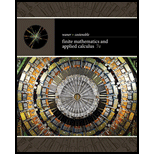
Study Techniques Your mathematics test is tomorrow and will cover the following topics: game theory, linear programming, and matrix algebra. You have decided to do an all-nighter and must determine how to allocate your 8 hours of study time among the three topics. If you were to spend the entire 8 hours on any one of these topics (thus using a pure strategy), you feel confident that you would earn a 90% score on that portion of the test but would not do so well on the other topics. You have come up with the following table, where the entries are your expected scores. (The fact that linear programming and matrix algebra are used in game theory is reflected in these numbers.)
Test
| Your Strategies | Game | Linear Programming | Matrix Algebra |
| Game Theory | 90 | 70 | 70 |
| Linear Programming | 40 | 90 | 40 |
| Matrix Algebra | 60 | 40 | 90 |
You have been told that the test will be weighted as follows: game theory: 25%, linear programming: 50%, and matrix algebra: 25%.
a. If you spend 25% of the night on game theory, 50% on linear programming, and 25% on matrix algebra, what score do you expect to get on the test?
b. Is it possible to improve on this by altering your study schedule? If so, what is the highest score you can expect on the test?
c. If your study schedule is according to part (a) and your teacher decides to forget her promises about how the test will be weighted and instead bases it all on a single topic, which topic would be worst for you, and what score could you expect on the test?
Want to see the full answer?
Check out a sample textbook solution
Chapter 5 Solutions
Finite Mathematics and Applied Calculus (MindTap Course List)
- 3. Solve the equation, give the answer exactly (no calculator approximations), and show all your work. (4 points) log5 2x = 3arrow_forwardLet I = f(x) dx, where f is the function whose graph is shown. 4 2 y f X 1 2 3 4 (a) Use the graph to find L2, R2 and M2. R₂ M2 = = = (b) Are these underestimates or overestimates of I? O 42 is an underestimate. O 42 is an overestimate. ◇ R2 is an underestimate. OR2 is an overestimate. OM2 is an underestimate. ○ M2 is an overestimate. (c) Use the graph to find T2. T₂ =arrow_forwardVector u has a magnitude of 23 and vector v has a magnitude of 83. The angle between the two vectors is 126 degrees.a) Draw a fully-labelled vector diagram showing the two vectors and the resultant vector when they are added together.b) Find the magnitude of the resultant vector.c) Find the direction of the resultant vector relative to vector u. Solding by finding the x and y of the vectors and addingarrow_forward
- 3) If a is a positive number, what is the value of the following double integral? 2a Love Lv 2ay-y² .x2 + y2 dadyarrow_forward16. Solve each of the following equations for x. (a) 42x+1 = 64 (b) 27-3815 (c) 92. 27² = 3-1 (d) log x + log(x - 21) = 2 (e) 3 = 14 (f) 2x+1 = 51-2xarrow_forward11. Find the composition fog and gof for the following functions. 2 (a) f(x) = 2x+5, g(x) = x² 2 (b) f(x) = x²+x, g(x) = √√x 1 (c) f(x) = -1/2) 9 9(x) = х = - Xarrow_forward
- practice problem please help!arrow_forward13. A restaurant will serve a banquet at a cost of $20 per person for the first 50 people and $15 for person for each additional person. (a) Find a function C giving the cost of the banquet depending on the number of people p attending. (b) How many people can attend the banquet for $2000?arrow_forwardAlt Fn Ctrl 12. Find functions f and g such that h(x) = (fog)(x). (a) h(x) = (x² + 2)² x+1 (b) h(x) = 5 3arrow_forward
 Elementary Geometry for College StudentsGeometryISBN:9781285195698Author:Daniel C. Alexander, Geralyn M. KoeberleinPublisher:Cengage Learning
Elementary Geometry for College StudentsGeometryISBN:9781285195698Author:Daniel C. Alexander, Geralyn M. KoeberleinPublisher:Cengage Learning
